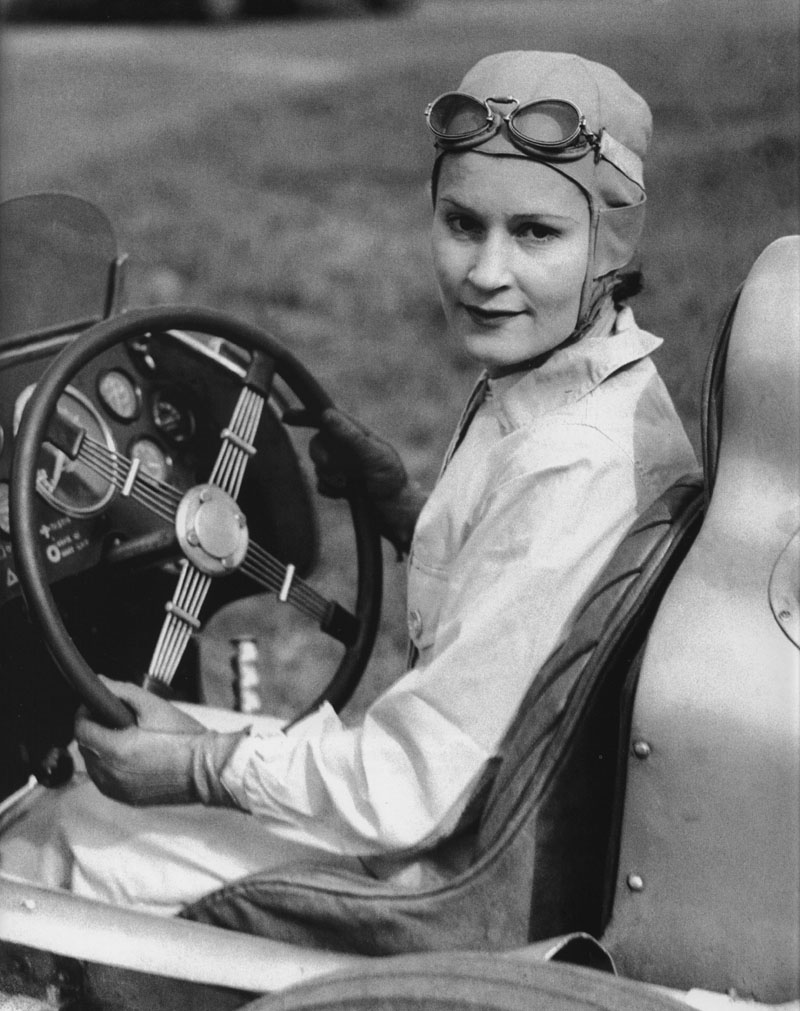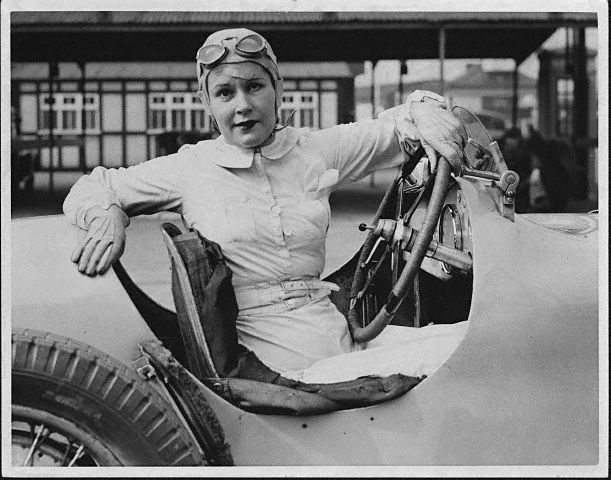*
The Canadian-born, Kay Petre was an early motor racing star at the legendary Brooklands track. The exploits of this 4’10” speedqueen made big news back in her day. Born Kathleen Coad Defries in 1903, she moved to England in 1930, following her marriage to Englishman Henry Petre. Henry was a keen flier who regularly took off from the Brooklands airfield– it was here that Kay first became interested in motor racing. She had always been a skilled and competitive sportswoman back at home, especially in ice-skating. Henry bought Kay her first car for her birthday, a Wolseley Hornet Daytona Special. Soon after her racing career began, with a third and a second in her first two races. In 1933, Kay purchased her first “proper” racing car, a 2-litre Bugatti. She used it to good effect in the regular handicap races at Brooklands, quickly adjusting to the handling and the increased speed.
One of the most famous images of Kay is her seated in the big 1924 Delage, a 10.5 litre V12-engined ex-John Cobb Land Speed Record car she had been racing. In order to reach the car’s pedals, she had them rigged with large wooden blocks. Petre threw down the gauntlet to her French rival on 26th October 1934, clocking 129.58 mph on a flying lap. The record stood until the August of 1935, when Gwenda challenged again, setting a new benchmark marginally faster. Not to be outdone, Kay jumped straight in the Delage and beat the record the same day, lapping at an average of 134.75 mph. this was the first time that a female driver had earned the Brooklands badge for a lap at 130 mph or over. Gwenda, driving her Derby-Miller special, joined that exclusive club three days later, hitting 135.95 mph. Kay admitted defeat graciously and went back to her own racing.
The racing legend Kay Petre in the pits at Brooklands, prepares for her first drive since an accident on the circuit, ca. 1938. © Hulton-Deutsch Collection/Corbis
Sadly, in 1937 Kay’s circuit racing career came to a dramatic end. During practice for the Brooklands 500 Miles, she was involved in a horrible accident which she was lucky to survive. Reg Parnell stalled above her on the banking, slid down and hit her Austin Seven, rolling it down the banking and crushing Kay underneath it. She suffered severe head injuries and was lucky to survive. After being in a coma for a few days and undergoing surgery to her head and face, she eventually made a good recovery, the only permanent damage being some paralysis of one side of her face.
After her recovery, Kay made one final appearance at Brooklands in 1938, driving the White Riley. Whether it was an actual race, public practice or merely some parade laps is unclear. She was cheered enthusiastically by the crowds but had lost her nerve and did not race there again. At this time, she was campaigning for Reg Parnell to have his racing licence returned. The authorities blamed him for the accident and revoked it, although Kay herself never held him responsible and eventually he was allowed back behind the wheel. her views were “If you race fast cars, one of the risks you take is that one day you might cop it!”

Kay Petre, the racing legend, recovers at her London home after an accident at Brooklands, ca. 1938. — © Hulton-Deutsch Collection/Corbis
After retiring from circuit racing, she could not get the motorsport bug out of her system and took up rallying, first as a navigator for the Singer team but later driving for Austin again, sometimes in a Grasshopper. She competed at home and in Europe, with the Alpine Rally being her favourite. One of her co-drivers was the French race Anne-Cecile Rose-Itier, who partnered her for the Monte Carlo Rally. It was at this time she began her second career as a motoring journalist, which she continued after the war. Much later, she was employed by Austin as part of its design team, selecting colours for the interior of the Mini, amongst other models.
Sierra “Smokey” Drolet, seen here in Birdcage Maserati, was a regular at SCCA Regional events in the Southeast in the late ’50s. The Birdcage was brand new when this photo was taken. It is chassis 2467, completed on July 12, 1960. It took a while to arrive in Chattanooga and was first raced by Jim Jeffords and Jim Hall in the September 11, 1960 Road America 500. Carroll Shelby also drove it in his last two races. He was fifth in the 1960 Riverside Times GP, and second on aggregate at the Laguna Seca GP a week later. via



Good articles, JP, I never even knew such a group or organization existed.
Female auto/motorracing was accepted abroad (pun intended) before it gained mainstream acceptance in the states — so some of the earliest, and most fascinating stories originated overseas.
JP
Pingback: THE WHITE TRIPLEX | THREE ENGINES, 1500 HP, AND ONE TRAGIC RESULT « The Selvedge Yard
Pingback: SHE RIPPED AND SHE ROARED | EPIC WOMEN OF DESTINY & DETERMINATION « The Selvedge Yard
Pingback: THE RUGGED ROAD | AN AMBITIOUS MOTORCYCLE JOURNEY FOR THE AGES « The Selvedge Yard